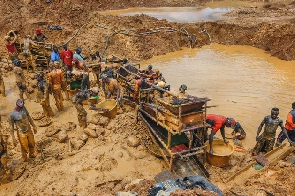It is a sign of our lack of confidence in our own nationhood that, whilst looking around for a solution to the problem caused by galamsey to the very survival of our country as a nation, we have not adequately explored the home-made, social remedies, that are readily at our disposal.
I mean the systems which our ancestors relied upon to create stable societies that were relatively free of heinous anti-social crimes. The societies we inherited and inhabited peacefully, before foreigners came to take our country over.
There is hardly any village in Ghana in which there isn't the remnants of a system for tackling emergencies that threaten the people's lives. For instance, if someone goes to his or her farm and does not return at the expected time; if people from one village travel to another and are not back at the time they had said they would return; if a river overflows its banks and threatens the lives of those who need to cross it to continue their farming or hunting activities; in these circumstances (as well as in many other similar emergency situations) every village and town possesses
an inherited social machinery through which the particular emergency can be efficiently tackled.
Each ethnic groups in Ghana have their own system of this nature (though many overlap, in the sense that although they are similar systems with the same objectives, the systems may have different nomenclatures or organisational structures). In the Akan society in which I was raised, the body charged with tackling emergencies is called the Asafo, or Kyirem unit.
(By the way: a former news editor of mine, at the Ghana Broadcasting System, Mr Osei Acheampong, taught me never to write “Asafo Company”. “Asafo”, he pointed out, means company, so “Asafo Company” is an awful howler or a “tautology!”).
The village or town Asafo is headed by an Asafohene, who sits at the apex of a structure evolved along military lines. The most important elements of the structure are the drummers group and the intelligence-gathering group (Akwansrafoᴐ).
As an aside: I was amused to find, as a sign of the ignorance of our customs and traditions in which we currently wallow, that a recently enstooled [April 2021] Akwansrafoᴐhene of Kyebi, was describedby the media as “The Chief who visits other towns”! Nonsense! He's the chief of the intelligence-gathering unit!).
The main body of the Asafo conprises, of course, the mass of the community. Each component has its own family head, or Opanin, who holds a high position on the Asafo. In an emergency, the Kyirem/Asafo drums are beaten, and each Opanin, upon hearing this alarm, changes into battle dress and summons his family members to meet him at his house.
They exchange intelligence about what's going on, and then they all troop to the Chief's palace or Ahenfie. This process is, of course, duplicated in each and every family and within a short time of the alarm being sounded, the palace is filled to capacity.
At the palace, they are formally informed of the type of emergency that has occurred, and they candidly discuss ways of tackling it. If they need tools or facilities that are not immediately available to them, they send word to the Chief, who would provide whatever is necessary. When they are satisfied that they have the means of combating the emergency, they set out for the bush.
When I was a child I had the goodfortune of seeing the Asiakwa Kyirem Unit in action. A woman called Maame Afia Mframa went to her farm and had not returned by nightfall. So, her kinsfolk raised the alarm. Her family head went to tell the chief drummer of the Asafo (as he was entitled to do) and the drums were beaten.
Within half an hour, the Chief's palace was completely swarmed with men – all donned in battle dress. Everyone at the palace knew that something “dangerous” had happened. They also knew their place in the “battle formation” of the town.
Next, the exact nature of the emergency was spelt out and people from Maame Afia Mframa's family were asked to lead the Asafo to go to her farm to search for her.
It took them just about an hour to find her body – she had been struck down by the branch of a tree, following a strong wind.
They picked up the body, wrapped it up and gave it to two young men from her family to carry. They then began the journey home, singing war songs and dancing in a frightening manner to demonstrate their valour.
They returned to the village to be met by everyone (including us children.) The older people prevented the kids from going too close to the carriers of the body. (It was deemed a taboo to allow young children to be exposed to possible psychological trauma, by seeing the horrendous things that could happen to the human body.)
The Asafo then divided itself into two groups – one to take the dead body to the mortuary at Kyebi, seven miles away, where there was also a government police station. (There was a “Native Authority” police station at Asiakwa, but it was not authorised to handle serious issues like death by accident, which needed technical details that only the Government police could collect).
Fortunately for me, this was the only emergency I saw with my own eyes when I was growing up. But other emergencies I heard about did occur: for instance, during a time when timber merchants "invaded" our forests without permission, to cut down timber trees. They, of course, ruined mosty of the roads that led to our cocoa and food farms. And, of course, they destroyed many food plants and young trees.
Also, the timber cutters came with sawyers, who dug trenches in our farms, put huge logs (that were not acceptable for export because there were crooks or lumps in their trunks) across the trenches, and cut them into boards to be transported away by truck.
The issue of the damage that the sawyers did to people's farmlands; what food crops were destroyed by felling the enormous mahogany or Odum trees; and all other ancillary problems, were heatedly discussed by the Asafo with the Chief and his elders – in public. They had to seek to reach agreement on acts of amelioration, especially, cash compensation to be paid to those affected, and how it was to be divided.
Everyone knew what had been agreed upon, so there was no possibility of “influential” people in the town (such as the chief and his elders) going behind the populace privately to corruptly collect backhanders from the timber merchants!
The Asafo was therefore the backbone of the entire society. So much so that a song to celebrate their deeds was composed and popularised by one of our guitar bands. It went like this:
Osee yeeeI!
Mmarima mmera oo!
Osee yeei! mmanin mmera! (Repeat)
Wᴐwo wo benyin n'Ԑse dԐ
Ԑnkᴐgoro Asafo eei,
Mmarima mmera ooo!
(Repeat)
(Translation:
Osee Yee ! A War Cry!)
If you're born a man
And you refuse to practise
Asafo manoeuvres,
There comes a day
When men are summoned
To come forward
And save their community,
Pray – what do you do, then?)
It was also through the Asafo that, if a Chief went against his oath to serve the interests of the people, laid-down steps could be initiated to bring him to order, and eventually lead to his destoolment (if he did not reform the ways that had offended the populace.)
Because of the role the Asafos played in destooling unpopular Chiefs, some Chiefs complained about them to the District Commissioners (appointed by the colonial government. The colonialists' measures with regard to the Chiefs, were often absorbed or imitated by our own governments, after independence).
Thus, quite often, government police forces have been known to be dispatcheds to "troubled" areas, to ensure that government interests – either in favour of, or against the Chiefs – were protected. Indeed, any perceived readiness for “unruliness” by the people, in support of demands for specific actions which brings conclict between them and their Chief, is often seizedupon shamelessly by the Government, to the detriment of -- both Chiefs and people!).
In the past, though, as soon as a split occurred between a Chief and his people and the central government intervened, the Asafo would revolt against both authorities. It's this that has led to a decline in the effectiveness of many Asafo groups.
Right now, virile Asafo groups are needed urgently in all the communities whose water-bodies and farms are being mercilessly ruined by galamsey operators. Some few Asafos (too few, alas!) have actually begun to obstruct, or threaten to attack galamseyers.
But even those Asafos that have managed to retain their relevance (such as the Effutu Asafos that continue to catch live deer during the Aboakyer festival of Winneba) have not yet deployed their full forces against galamseyers.
Unfortunately, mainly aren't now mainly a culturraql show-piece, who just display flags and dances through the streets. If only they could rediscover their ancestral militancy!.
It is clear that if the Akufo-Addo government is really serious about ending the galamsey menace, it must vote a sum of money to the traditional authorities – through the Ministry of Chieftaincy Affairs and the Houses of Chiefs – to organically revive the Asafo groups.
This should be done outside the box – that is, out of the controlling hands of corrupt officialdom. Otherwise, we shall be doing “the same thing different”!
In other words, galamsey criminals should be caught with the assistance of the Asafos, but none of the "eye service" only fanfare should be rolerated. That happened a lot during “Operation Vanguard's” forays into galamseyers' territory, when nothing whatsoever happened to the criminals.
Yet the government had prescribed such harsh punishment from the judiciary -- through aCT 995 of 2019 - as could deter the galamseyuers from further destruction of our sources of life – water.
It has been disheartening to watch as galamseyers, especially Chinese nationals – are caught on illegal sites, armed with pump-action shotgun -- mostly unlicensed - but with nothing happening to them! What, for God's sake, did the government enact Act 995 of 2019 for? (By the way, I have published the Act's provisions in detail, in a previous article.)
If the Asafos are drafted to become the main source of information and arrests against galamseyers, they will also follow through and pack the courts in their numbers, to ensure, with their presence, that the law providing for harsh punishment for galamseyers, is enforced to the letter. Thus only can deterrence against galamsey be procured.
Make no mistake – if and when the government and the masses work together, through the Asafos, nothing can withstand their combined prowess. We have a precedent for that: the way and manner in which the “Cocoa Rehabilitation” [CR] programme of the 1940-50s became such a huge a success, despite the initial hostility that greeted the colonial method of “cutting-out” cocoa trees affected by the swollen shoot disease, points to the fact that if and when the government understands the psychology of the people, and carries out an honest and practicable programme (not limited to words!) the problem will be uprooted and not only “managed” for political purposes.
By the way, here is a historical note to buttress my plea for a revival of the Asafos: it was what he observed of Asante military and social formations, during his command at the head of the British army that invaded Asante in 1896, that inspired Major Robert Baden Powell, founder of the World Scouts Movement, to formulate and launch the “Boy Scouts” idea, on his return to Britain.
He based many of the techniques for military-type activity, disguised as civilian pursuits, that he taught the Scouts, on Asante military strategy.
Baden-Powell was particularly impressed by the Asantes' ability to reconnoitre the positions of their enemies in the jungle, communicate information secretly to the main bases of their army, and launch surprise attacks.
He would be surprised if he went to Asante today and found that galamseyers have been allowed to destroy water-bodies, turn cocoa and food farms into a moon-like landscape, dominated by craters filled with stagnant water and algae, whilstAsante towns and villages are still full of men!
More practical methods for reviving the Asafos and inciting Asafo action against galamseyersa – without straying into harmful vigilantism – will be discussed in future articles. I urge readers who have views on this subject to bombard the media with articles and “Letters To The Editor”, to disseminate their ideas. The struggle should not be left to journalists alone, for it is rally, a struggle for national survival, no less.
Opinions of Wednesday, 21 April 2021
Columnist: Cameron Duodu















